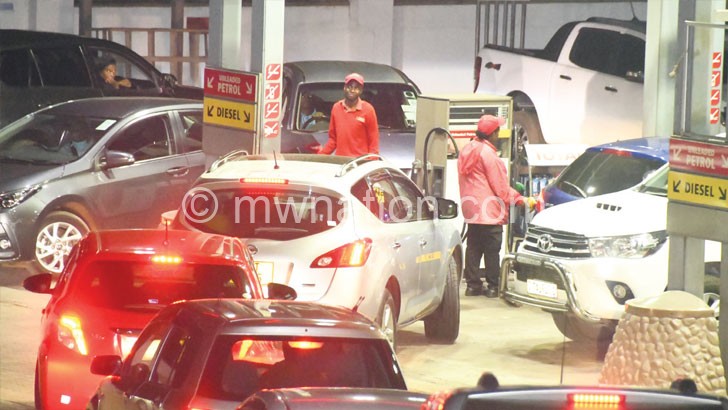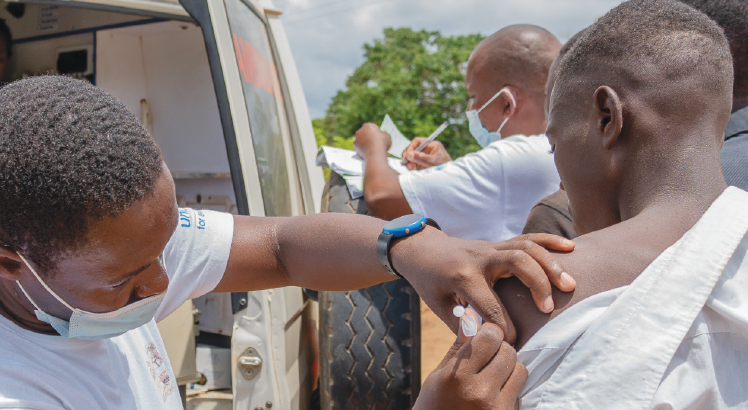With K10 000, a Malawian motorist was yesterday buying seven litres of petrol, but following a 34 percent fuel hike effected at midnight that amount now buys only five litres.
Amid global fuel prices surge owing to the Russia-Ukraine war and the recent 25 percent devaluation of the kwacha, Malawi Energy Regulatory Authority (Mera) last night increased fuel prices by an average of 34 percent.
Yesterday’s fuel price hike follows another 22 percent price increase that Mera announced on 10 April 2022.
Vehicles queue to refill at a filling station
Based on the new prices, petrol is at K1 999 from K1 380 per litre, representing a 44.92 percent increase, diesel is at K1 920 from K1 470 per litre, representing 30. 61 percent rise while paraffin now sells at K1 236 from K956 per litre, representing 29.29 percent hike.
Briefing the media last night in Lilongwe, Mera chief executive officer Henry Kachaje said fuel the automatic pricing mechanism was fully applied including elements in the fuel price build-up such as Free On Bord (FOB) rates and In Bond Landed Cost (IBLC) losses.
He said: “Under the automatic fuel pricing mechanism, retail prices respond to movements in the FOB prices as monitored on the World market and the exchange rate of Malawi kwacha against major trading currencies.
“We understand the economic challenges that Malawians are going through, but given prevailing circumstances, we were left with no choice but to effect the price increases. Unfortunately, our Fuel Stabilisation Fund is depleted and does not have capacity to cover import losses”.
Kachaje said they could not remove fuel levies because they are legally binding requiring the government to consider reviewing the laws on levies.
He said currently with the revamping of rail transport for fuel, prices would eventually be fair saying currently, the volumes that use rail are insignificant to bring change.
Consumers Association of Malawi executive director John Kapito said the new prices especially on Diesel and petrol will seriously collapse what ever was left on the economy.
He said: “Malawians cannot survive with these increases which will trigger huge prices on market at the same time collapse some of the industries and declare most workers unemployed.
“Despite the huge devaluation we have observed that the kwacha is depreciating daily and yet there is no IMF assistance.
“I am very concerned with the many poor consumers that can no longer have a meal in a day and what these increases mean to them is that our leaders are well cushioned as their salaries are well insulated to cushion them from any price adjustment.
Reacting to the development, economist Milward Tobias said government can consider reducing or suspending some levies as at close to $2 per litre, this may be the highest fuel price in dollar terms.
He said: “The impact is well known. It will fuel further inflation which already has been on an upward trend. People’s income will buy less goods than has been buying. Households should prioritise spending in these economically difficult times”.
On the another hand, Mera observed that since the last IBLC review in April 2022 when pump prices were last revised, the losses which will have to be paid to suppliers stand at K77 billion, up from K39.266 billion in March 2022.
Mera also said all the three products qualified under the automatic pricing mechanism for a price revision since the changes of the landed costs is beyond the ±5% trigger limit.
Consumers Association of Malawi executive director John Kapito is on record as having said rising fuel prices are inevitable and urged the government to adjust quickly to avoid accumulated and shocking increases that can be disruptive to households, firms and the economy in general.
Surfing on global trend on oil prices in November 2021, petrol was selling at $747.36 while diesel was at $685.33 per metric tonne, however, as at May prices for petrol shot to $1 227.46 while diesel rose to $1 134.32. The prices are actuals minus all the other logistical costs including transportation, insurance and intransit losses.
The post Fuel prices hiked 34% appeared first on The Nation Online.
 Moni Malawi
Moni Malawi 

